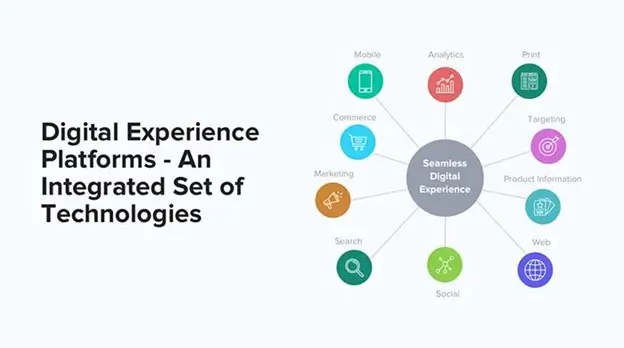Get your free consultation today!
Share with your Colleagues
Categories
ROI Calculator
Moonstone Interactive is the only San Francisco Bay Area web design firm and Internet Marketing expert that offers a free online ROI Calculator
Author: Steve Herz

Table of Contents
- What Are Digital Experience Platforms?
- What Makes Up a Digital Experience Platform?
- Why Do You Need a Digital Experience Management Platform?
- How to Choose the Best DXP For Your Business
- Optimize Digital Journeys with Moonstone Interactive
- FAQs About Digital Experience Platforms
Creating a standout digital presence isn't just a nice-to-have anymore—it's a must. Customers today expect more than just a functioning website or app; they want smooth, personalized experiences across every digital channel they have.
Managing all these touchpoints can feel overwhelming, but that's precisely why businesses are turning to Digital Experience Management Platforms (DXPs). These platforms combine everything, helping you manage and optimize every interaction to ensure your customers have a consistent, engaging experience, no matter where they connect with your brand.
Let's take a closer look at how DXPs make this possible.
What Are Digital Experience Platforms?
A Digital Experience Platform (DXP) is software that manages all aspects of users' online experiences. It combines various tools and technologies that allow you to create, manage, and optimize interactions across websites, apps, social media, emails, and other digital channels.

Think of a DXP as the central hub to manage your users' digital experience. A DXP ensures user experiences such as browsing the website, using mobile apps, and engaging in social media are smooth, consistent, and tailored to their preferences. The main goal of DXP is to improve customer engagement by delivering personalized and meaningful content and helping businesses collect data and insights to understand user behavior better.
What Makes Up a Digital Experience Platform?
Now that we've defined what a DXP is, let's break it down into some of the essential parts:
1. Content Management System (CMS)
The CMS is the control center for your website content. Content management systems enable you to quickly create, edit, and organize content from blog posts to product pages.
The goal? Ensure all your content is up-to-date and consistent across different digital platforms, such as your website, mobile app, or emails.
2. Analytics and Data
A solid DXP gives you the tools to track what's going on with your customers. It tells you how people interact with your website or app, what they're clicking on, and what's making them bounce away.
These insights help you determine what's working and what's not and where to make changes to keep your customers happy.
3. Personalization
People engage in experiences they feel are just for them. With a DXP, you can personalize content based on user interests, past actions, or location.

4. Automation Features
Most DXPs come with automation tools that take the load off you. Tasks such as scheduling content updates, sending personalized emails, or managing customer data can be done automatically, saving you time and ensuring you don't miss any critical details. This automation allows you to focus on other essential aspects of your business.
5. Integration with Other Tools
One of the best things about a DXP is that it plays nicely with your existing tooTasks ls. Whether it's your email marketing platform, CRM, or social media tools, a DXP can connect with them so everything runs smoothly together.
DXPs include commerce features, allowing you to sell products or services directly through digital touchpoints. Whether you have an e-commerce store or subscription service, integration within a DXP simplifies the shopping process, making it easy for customers to purchase.
It also integrates with your inventory and order management systems to keep things running smoothly behind the scenes.
6. Digital Asset Management (DAM)
The Digital Asset Management (DAM) system stores, organizes and manages all your digital assets—images, videos, documents, and more.
A DAM helps you track all your brand's digital files and ensure that everyone on your team has access to the right assets when needed. This makes all content look professional and aligns with your brand's identity across the customer journey.
7. Customer Relationship Management (CRM)
A CRM within a DXP manages customer interactions and data throughout the customer lifecycle. It helps businesses track customer information, preferences, and behaviors, allowing for more personalized and meaningful engagements.
With the CRM, you can quickly segment your audience, automate follow-up messages, and provide more personal customer support.
Why Do You Need a Digital Experience Management Platform?
Businesses can't afford to fall behind in creating great customer experiences. Keeping everything consistent and personalized can be a real challenge, as there are many ways for people to interact with your brand. That's where a Digital Experience Management Platform (DXP) comes in to save the day.
Are you still wondering if your business needs a DXP? Let's explore why having one can make all the difference in your digital transformation.
Consistency Across All Channels
Consider it: customers today expect the same experience, whether browsing your site on their laptop, scrolling through your app, or checking out your social media. Without a DXP, keeping all those platforms on the same page can feel like a juggling act.
A DXP ties everything together so that your brand's message, tone, and look are consistent everywhere. It's like having one central hub for all your digital efforts, which helps build trust and keeps your brand looking polished.
More Personalized Experiences
Everyone loves feeling special, and your customers are no different. They want content and recommendations that speak directly to them.
A DXP gives you the tools to make this happen. By gathering data on your customers' behavior—what they click on, how long they stay on a page, what products they've browsed—you can tailor their experience to meet their needs. The result? A more engaging customer experience that keeps them coming back for more.
Increase Customer Engagement
Getting people to visit your website or app is one thing; getting them to stay and engage with your content is another. A DXP can help you improve customer engagement by tracking how people interact with your brand online.
Are they abandoning their shopping cart? Are they leaving your site too soon? A DXP provides insights into these behaviors so you can tweak your content and layouts, and it offers to keep people engaged and interested.

Save Time with Centralized Management
Managing multiple digital platforms can feel like a full-time job. From updating content to managing campaigns, it can quickly get overwhelming. A DXP makes this easier by letting you handle everything from one central spot, providing relief and ease.
You can schedule content updates, send personalized emails, or launch marketing campaigns without switching between tools. This is a huge time saver and reduces the risk of things slipping through the cracks.
Data-Driven Decision Making
If you've ever wondered what's working and not in your digital strategy, a DXP can answer you. It collects real-time data on your customers' behavior—what they're clicking, what they're ignoring, and how they're navigating your site.
You can make smarter decisions for better digital experiences with all this data. For example, if many users leave your site at checkout, you can use that insight to make improvements that encourage them to complete their purchase.
Room to Grow
As your business grows, your digital needs grow, too. You might add more products, expand to new markets, or launch new marketing channels. The beauty of a DXP is that it can grow with you. Whether you add more users, increase your workload, or expand your digital presence, the right DXP can keep up.
How to Choose the Best DXP For Your Business
The right DXP should facilitate your business needs, integrate smoothly with your existing systems, and help you deliver great digital experiences to your customers. Here's a simple guide to help you make the right choice.
1. Identify Your Business Needs
Before exploring the options, consider what your business needs from a DXP. Are you looking to improve customer engagement? Do you need better data and insights? Or maybe you're trying to streamline content management across multiple platforms.
Whatever your goals, knowing what you want will help you narrow down your choices.
For example:
- To personalize the user experience, look for a DXP with robust personalization features.
- If your team struggles with managing content, prioritize a platform with a solid content management system (CMS).
- If improving customer interactions is your goal, focus on DXPs with built-in CRM tools.
2. Check for Integration Capabilities
A DXP should integrate easily with the tools and systems you're already using. If the DXP doesn't connect well with your existing software, you'll face roadblocks that slow productivity and create unnecessary headaches.
Ask the following questions:
- Does the DXP integrate with my existing tools, such as my CRM or marketing automation platform?
- Can it work with my e-commerce systems to provide a smooth shopping experience for customers?
- Will it easily connect with my analytics and data tracking tools?
3. Look for Personalization Features
The best DXPs offer personalization features that enable you to tailor content, product recommendations, and offers based on each user's preferences and behavior.
When considering personalization features, think about the following:
- Can the DXP segment users and target content to different audiences?
- Does it track user behavior and preferences to deliver relevant content?
- How easy is it to set up personalized experiences?
4. Consider Ease of Use
A DXP will make your life easier and not more complicated. Select a platform with a simple, intuitive interface that your team can use without extensive technical knowledge.
Make sure to:
- Choose a platform with a user-friendly interface.
- Test the platform with your team to see how quickly they can pick it up.
- Confirm that the platform has excellent customer support and documentation to help with onboarding.
5. Evaluate the Analytics and Reporting Tools
A DXP should provide robust analytics and reporting tools to help you track user behavior, engagement, and other vital metrics. These insights will guide your decision-making and show you what's working (and what's not) in real time.
Consider:
- Does the DXP provide detailed reports on user interactions?
- Can you track key metrics such as engagement, conversions, and customer journeys?
- Are the analytics easy to understand and use?
6. Scalability
As your business grows, your needs will expand. Your DXP should be able to grow with you. Choosing a platform that can scale up to meet your expanding requirements is essential.
Ask yourself:
- Can this DXP handle more users or content as my business grows?
- Does the platform offer upgrades or additional features as my needs change?
- Is there support for new technologies or channels that might be important?
7. Cost and Value
Finally, it is vital to balance your budget with the features. While some DXPs offer an impressive range of tools, you might not need every feature they provide, especially if you're a smaller business.
Look for a platform that offers the best value for your money, focusing on the features that will most impact your business.
When comparing costs, consider:
- What's included in the pricing? Are there extra fees for certain features?
- Does the platform offer different pricing tiers to match your business size?
- Can I achieve a reasonable return on investment by improving customer engagement and driving sales?

Optimize Digital Journeys with Moonstone Interactive
Delivering a seamless and personalized experience is more than just a trend—it sets successful businesses apart. A Digital Experience Management Platform (DXP) gives you the tools to keep your customers engaged and your digital channels working smoothly. Whether managing content, automating tasks, or personalizing interactions, a DXP helps you stay ahead while scaling your business as it grows.
Ready to elevate your digital marketing strategy? Moonstone Interactive can help you unlock the potential of top DXPs and surpass customer expectations. Contact us today for a free consultation and start transforming your digital experience!
Moonstone Interactive is a certified developer for two industry-renowned DXP platforms: Kentico Xperience and Optimizely DXP. Contact Moonstone today for a free consultation!
FAQs About Digital Experience Platforms
What does a digital experience platform do?
A digital experience platform helps businesses manage and improve customer interactions across various digital channels. It can handle everything from content management and personalization to data analysis and automation.
How is a DXP different from a CMS?
While a CMS is focused mainly on content creation and management, a DXP goes a step further by offering tools for personalization, analytics, and automation. A DXP provides a more complete solution for managing digital experiences and improving customer satisfaction.
Do I need technical skills to use a DXP?
Not necessarily. Many DXPs are designed with user-friendly interfaces, so even non-technical team members can use them. However, having someone on your team who understands the technical side can be a plus.


